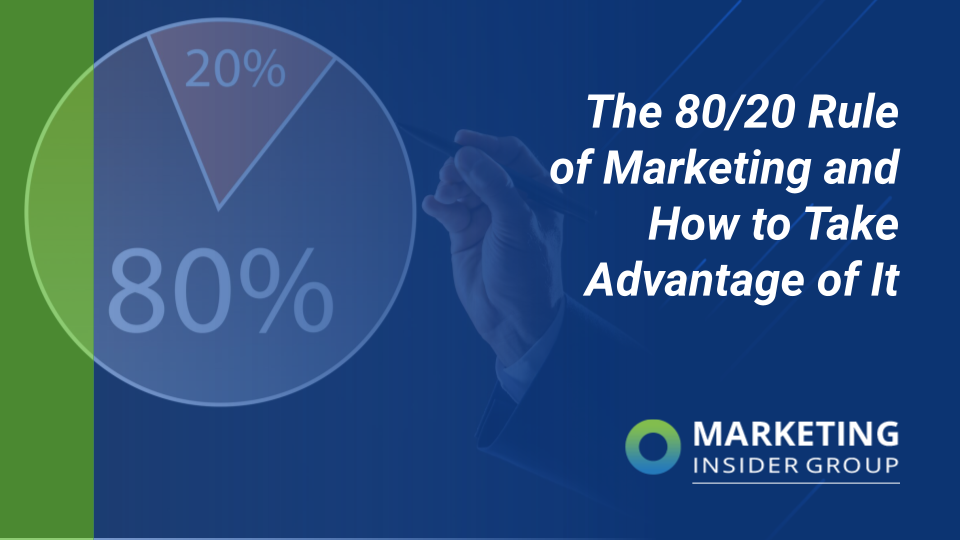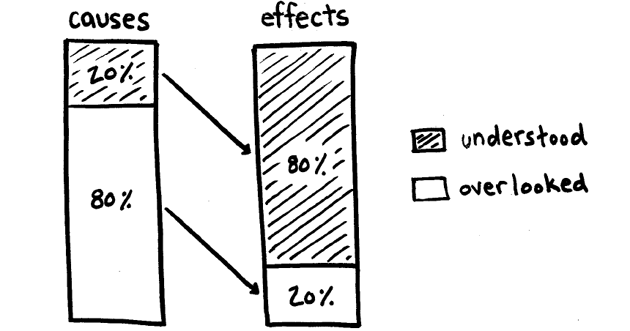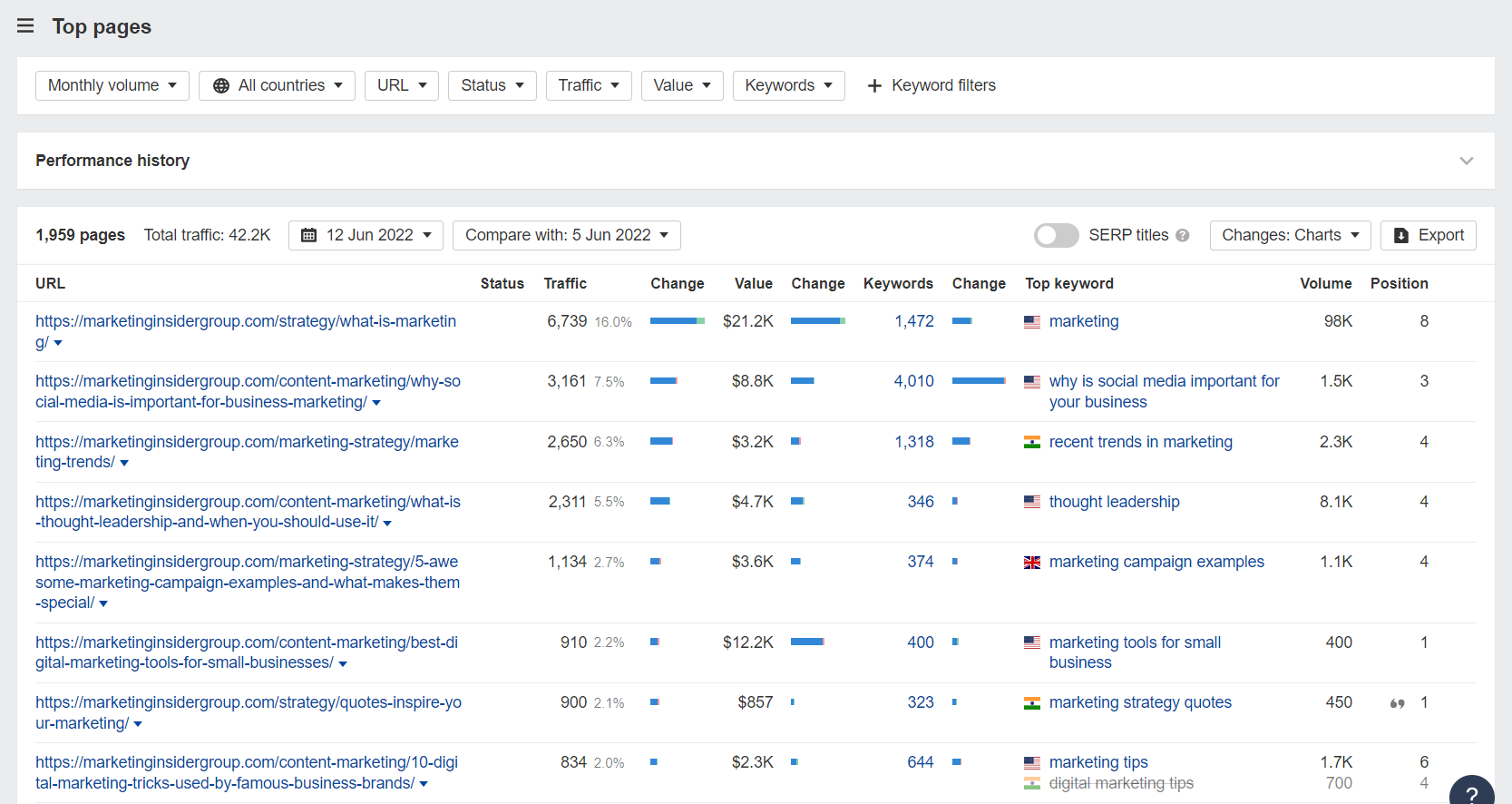The 80/20 Rule of Marketing and How to Take Advantage of It

More than a hundred years ago, Italian economist Vilfredo Pareto noted that about 80% of the land in Italy belonged to approximately 20% of the country’s total population. He went on to infer that the majority of wealth in a free-market economy is concentrated in the hands of a relatively small group of people — roughly 20 percent of the population.
This ultimately gave rise to the 80/20 rule, also known as the Pareto Principle. In essence, the Pareto Principle infers that there’s an 80-to-20 relationship between effects and their causes.
The Pareto Principle transcends disciplines. In sports, for example, you’ll find that at least 20% of athletes win 80% of the time, or that roughly 20% of training and exercise impact 80% of an athlete’s performance. Similarly, when it comes to the economy, about 20% of people create more than 80% of the total wealth of the nation.
What’s the implication for your business? The 80/20 rule suggests that 80% of your company’s revenue comes from 20% of your selling efforts. Alternatively, you could say that 20% of what you do is responsible for 80% of your profits.
Is The 80/20 Rule Really True? Or Useful in Business?
The 80/20 principle is based on empirical and anecdotal evidence more than a scientific fact. It might not be totally accurate or precise, but statistics across industries support the rule’s validity. Salespeople, leaders, consultants and others have demonstrated time and again that the 80/20 rule holds its ground when it comes to team or individual performance, best practices and management strategies, routine tasks, operational processes, or high-level business insights.
At its core, the 80/20 rule is all about identifying your best business assets and using them effectively to maximize value creation.
In order to create maximum value in business, you have to apply the 80/20 rule in the context of cause-effect relationships in various areas. This way, you can zero in on the USP that is bringing you 80% of your revenue or the root cause of 80% of your problems.

Applying the 80/20 Principle in Marketing & Sales
In the sales and marketing ecosystem, you can use the 80/20 rule as a guide to come up with highly effective marketing campaigns as well as sales best practices by asking questions such as:
- Who are our most valuable and loyal customers?
- Which marketing channels bring us the most conversions and sales?
- Which are our best-selling products or services?
Once you formulate and answer these pointed questions for self-discovery, here are a few strategies to help you focus your attention and resources on your top 20% tactics, customers and channels.
Top 20% Customers
You probably have hundreds or thousands of contacts on your client and prospect lists from your website, and email and social media marketing efforts. Keep close tabs on which customers made a recent purchase, are frequent buyers, or which ones were generous in their purchases.
Once you’ve identified them, tag them as a top priority for your sales and marketing efforts and use their customer data to help you find and attract new audiences.
Certain clients are always going to be your high-volume buyers, but it’s important not to take them for granted. Don’t lose touch with your core clients while acquiring new customers or dealing with problem clients. Make sure that you’re always providing a superior customer experience to your best clients. Keep them delighted with your service, keep engaging with them on a more personal level, and continue exploring further business opportunities with them.
Top 20% Geographical Regions
Once you’ve identified your most profitable customers, the easiest common ground to look for is where they reside. If you’re in retail or in service such as food delivery, wedding planning or cab booking, chances are you find more valuable customers in wealthier neighborhoods.
Look for trends in your POS platforms, paying special attention to where these customers are. You’ll notice that certain locales, cities or regions are far more lucrative than the rest, obviously due to the presence of a high-income customer segment. You can then leverage this information to boost your sales and marketing strategies in these locations.
Top 20% Marketing Channels
The explosion of content marketing in a variety of forms lately means marketers are spoilt for choices. Given the gazillion platforms, websites, media formats and outlets out there, how do you decide where to focus your finite resources?
The 80/20 rule says that only a fifth of all your channels will bring you great results. So, while spray-and-pray is the default approach, a bit more common-sensical thing to do would be to
- Identify the channels where a significant number of your potential customers are present.
- Narrow down the ones that your team is good at targeting.
- Formulate effective strategies to engage and convert more on those channels.
Top 20% Niches
During the selling cycle, you’ll likely come across customers who exhibit particular behaviors that signal buyer intent. Use this information to identify commonalities among prospects actively looking to make a purchase, and build on their experiences to drive them along your sales funnel.
The concept of “niche” doesn’t apply just to customers — it pertains equally to industries, customer segments, or product mix. Any of these niches may bring in a significant amount of sales temporarily or for an extended period of time.
Top 20% Content
Every company worth its salt is using content marketing to build brand awareness these days. This takes on a lot of forms, the most popular (and worthy) being blogging and website content (promoted on Google using SEO) and social media on platforms such as Facebook, Twitter and Instagram.
Organic traffic is one of the most ROI-intensive outcomes of building an informative and engaging website. Visitors who click-through to your site from Google from a search result that matches their intent have one of the highest chances of converting to paying customers. Again, perhaps the top fifth of your pages bring you the bulk of your high-converting traffic.

Social media is another area where there’s a large number of strategies to try out, a hundred possible outcomes, but only a few things that will work out for you. This could be one or more of the following:
- Industry news
- Images with quotes from industry leaders
- Behind-the-scenes videos
- Short how-to videos
- Screenshots of digital products
- AMAs
- A handle exclusively used for customer service
Again, the timing of your content also matters — posts published on Friday evenings could trigger 80% of your online visibility and engagement!
Top 20% “Problem” Customers
Whether you like it or not, you’ll be dealing with hard-to-please or overly demanding customers (or even industry influencers or activists if you’re a well-known brand) who test your patience and pull down your productivity numbers through recurring questions, impossible-to-meet requests or highly visible spats on social media.
If you’re not taking their feedback seriously, or even if you’re bending over backwards to please them, it means you’re not setting and meeting expectations right. Take a deeper look at these customers and their buying habits. Are they in your top 20%? Are you losing precious time engaging with and responding to customers who, in the long run, simply may not be worth the effort? Can you turn their wrath into wins?
Top 20% Employees or Salespeople
Every sales team has its share of celebrated top performers. These are the people who have your customers eating out of their hands. Take note of their approaches, their behavior, their attitude and the way they treat customers.
All this information should be packaged and turned into a training manual for the rest of your sales force. And oh, add that to your employee advocacy program too!
Top 20% Capital Invested
“Half my advertising spend is wasted; the trouble is, I don’t know which half,” retail magnate John Wannamaker is believed to have told Lord Leverhulme.
You have a bigger job — you need to know the 80-20 split!
Are you making your money work for you? Which part of your operational costs are yielding better returns consistently? What money is routinely going down the proverbial drain?
Managing your costs works on many levels: it helps you save by avoiding counterproductive measures and enables you to make good budget decisions. For example, you might decide to let unproductive salespeople go while augmenting your remaining team’s daily cookie allowance (a direct factor that affects productivity and efficiency at work).
Finding Your Marketing Mojo
We’ve all wondered at some points why some team members, products, campaigns and client calls seem to produce radically better results than others. You now know the mechanics, if not the reason, behind this.
A caveat: The Pareto Principle simply shows how things work. It doesn’t mean there’s something inherently wrong with the other 80% of your efforts or people. This is a logical fallacy that many experienced leaders fall for. Sometimes, the best way forward is to pick the 20% and run with it without judging the remaining 80%.
The 80/20 rule can provide a solid framework for your sales and marketing objectives. Whether it concerns customers, salespeople, marketing campaigns or company resources, it’s definitely worth your while to keep the Pareto Principle as a guiding light for decision-making.
The post The 80/20 Rule of Marketing and How to Take Advantage of It appeared first on Marketing Insider Group.




